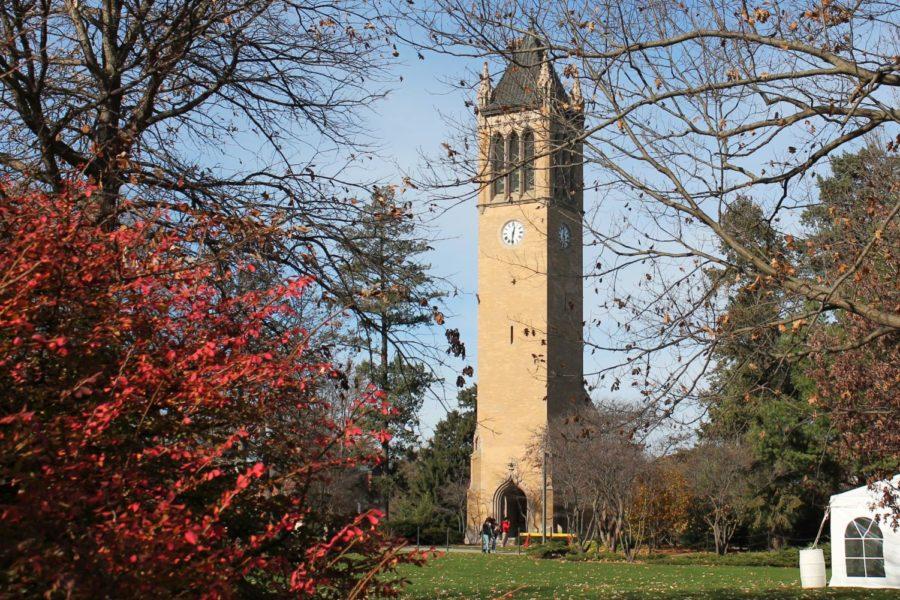- App Content
- App Content / News
- News
- News / Politics And Administration
- News / Politics And Administration / State
Funding for higher education: tuition continues to cover majority of university costs
January 10, 2018
Iowa Gov. Kim Reynolds released her budget Tuesday, recommending an appropriation to Iowa State which follows a pattern of state funding remaining generally flat despite growing costs to the university.
Since 2009, the university’s expenditures have grown over $200 million. Reynolds recommended an appropriation of about $171 million which is more than $9 million less than the appropriation to the university in 2008.
The amount of revenues the university receives each year has increased around $267 million since 2008. The increase is partially due to yearly record enrollment over the last decade.
At the start of the 2017 fall semester, enrollment dropped slightly, ending the streak.
Tuition and fees revenues have increased due to yearly tuition increases as well.
Over the past two decades, the percentage of university expenses covered by tuition and fees has grown considerably. In 2000, 24.6 percent of university expenses were covered by tuition.
For 2018, the estimated tuition and fees will cover about 69.7 percent of the costs.
In “Governing States and Localities” by Kevin B. Smith and Alan Greenblatt, increased tuition dependence and decreased state funding is said to be caused by the 2008-2009 Great Recession.
Smith and Greenblatt wrote that in 2000 the state appropriations in 47 states covered a larger portion of higher education than tuition and fees. Today, in around half the states, students cover a majority of the university’s costs.
It also states that in the mid-1980s, state governments across the country regularly covered 50 percent or more of the university’s costs.
Reynolds recommended a midyear budget cut to the Board of Regents of $5.1 million in her fiscal budget. Budget cuts to 2018 became a necessity after the Legislative Services Agency announced in December that Iowa’s finances had an estimated shortfall of $37 million.
Regents Executive Director Mark Braun sent out an email statement after the governor announced her budget recommendations.
Reynolds proposed cuts amounting to $27.1 million.
“We will work with our institutions to make any required fiscal year 2018 reductions in ways that have as little impact on students as possible,” Braun said.
Reynolds recommendations follow state budget cuts to all the regent universities last year which resulted in Iowa State being cut $9 million.
Rep. Beth Wessel-Kroeschell, D-Ames, said Friday she heard from administrators that there will be a proposed $2.5 million in midyearcuts to Iowa State.
Wessel-Kroeschell spoke out against the lack of funding the state puts toward higher education.
“I know that money isn’t the only thing,” Wessel-Kroeschell said, “but by starving our schools, we are creating problems at all levels, and we are at that level where we are starving our institutions.”
At the August regents’ meeting, Benjamin Allen, interim president of Iowa State at the time, proposed yearly increases of 7 percent for in-state and 4 percent for out-of-state students, which would end in 2022.
By the end of the five years, the yearly increases would accumulate to $3,081 for in-state undergraduate students and $4,613 for out-of-state undergraduate students.
The university’s State Relations Officer Kristin Failor told Student Government the proposed tuition increases were not feasible. Wessel-Kroeschell also called it an extreme proposal.
Sen. Herman Quirmbach, D-Ames, said he disagrees with the tuition increase, but understands the university must make up for the budget cuts.
“The university has to bring in additional funds to make up for the budget cuts and to keep the lights on and pay competitive salaries and the whole deal. We have an expanding student body,” Quirmbach said. “I don’t think we’ve kept up with the capacity needs.”
Iowa State President Wendy Wintersteen requested $5 million from the state to go toward in-state undergraduate financial aid.
During Wintersteen’s legislative request presentation, the visual aid stated 52 percent of Iowa State graduates stay in Iowa—63 percent of resident graduates, 24 percent of non-residents and 28 percent of international graduates.
Reynolds recommended $1.9 million less to Iowa State than Wintersteen’s full request.
Rep. Lisa Heddens, D-Ames, spoke out against the decreased funding and budget cuts to higher education Saturday.
“We want to ensure that we are providing funds so that tuitions aren’t going up [to] double digits for students and their families and that we’re able to maintain quality education within the state of Iowa,” Heddens said.
Budget decisions currently fall on the Iowa legislature before it’s time for Gov. Reynolds to sign anything off. Here are some state legislators from the House and Senate education committees and their contact information:
- Walt Rogers
- 515.281.3221
- [email protected]
- Jon Jacobsen
- 515.281.3221
- j[email protected]
- Amy Sinclair
- 641.870.0199
- [email protected]
- Jeff Edler
- 641.751.5902
- [email protected]







